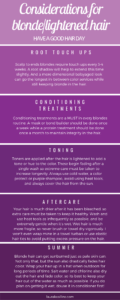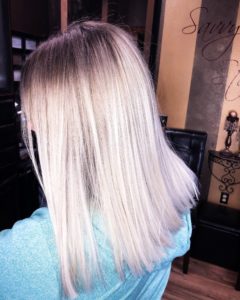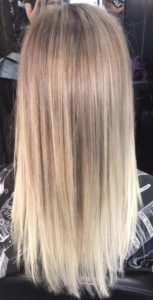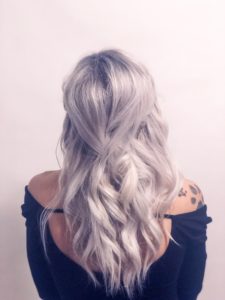5 Useful Tips For Blonde And Bleached Hair

Blondes, especially platinum blonde and fantasy colors are all on trend right now. And let’s face it, blondes do have more fun! But along with the fun, blonde is an extremely high maintenance color. And by high maintenance, I don’t just mean frequent visits to the salon. This also means the amount of TLC that you put into your hair at home.
Before taking the plunge, make sure you know what you’re getting yourself into as there are several key considerations. If you’ve already taken the plunge, this guide will help you stay on track to keeping your blonde hair in its best condition ever.
Tips To Keep Blonde Hair Healthy

- Root touch-ups
- Conditioning treatments
- Toning
- Aftercare
- Summer tips
***Since I’m sharing the products that I love to use with you guys, my posts may include affiliate links to these products. If you take action and purchase a product through clicking one of my links, I’ll make some commission money from it at no extra cost to you. This enables me to be able to continue giving you awesome hair tips, so thanks! ***
Blonde root touch-ups
The first considerations are the different options for up-keeping your roots. New-growth begins to show in as little as 2 weeks; I start to notice a dark line appear after just one week!
Depending on what type of blonde you are; scalp to ends, highlights, balayage–will all make a difference in when you’ll need to get your roots touched up. We’ll cover each option below.
Scalp to ends blonde
If you plan on being a full-on scalp to ends blonde babe, then be prepared for frequent root touch-ups. If you don’t want to rock a rooty look, you’ll be visiting the salon every 4 weeks. At one point in my life I was coloring mine every 3 weeks!
If you push this longer than 6 weeks, the service becomes more work which means it costs more money. If your roots get to be longer than 1/2 inch, then your stylist now has to foil anything past that 1/2 inch, let that process, and then go back for the 1/2 inch near your scalp.
This is because the first 1/2 inch of new-growth will process quicker than the rest of the hair. The heat from your scalp speeds up the process. So to avoid having bands of discoloration, it is best to not push this service out.
An exception to this is if you’re able to use hi-lift hair color instead of bleach. Typically you can only do this if your natural color is a level 6 or above. So if your natural color is dark, unfortunately this is not an option for you.
Keep in mind that hi-lift color will not get you as icy as bleach will. So you’ll have a little more warmth to your blonde. But this is a healthier alternative and you can push this service to every 8 weeks.
Blonde with a root shadow

More recently, a lot of blondes are choosing to go with a root shadow. This is a great alternative to a scalp to ends blonde. A root shadow is darker than your blonde, but lighter than your natural hair at your base. This option can typically go anywhere from 6-12 weeks without needing any root service.
This blends your re-growth so you’re able to go longer between visits while still keeping a very light all-over look.
But keep in mind that when the blonde does need to be touched up, it will be a longer and more expensive service than a typical root touch-up. This is because foils will be needed to break through the darker color away from the scalp, as well as the use of the root shadow color.
Blonde highlights
A typical blonde highlight is probably the most common service for blondes today. This is a typical foil service that can go anywhere from 8-24 weeks depending on how heavy the highlight is.
The heavier the highlight (heavier meaning the more blonde), the sooner you will need to come in. You also do not need to do a full highlight every time, and can get away with a partial, halo, or face framing highlight in between the full service.
I also like to mix highlights with a root shadow, which makes it a little more natural looking when the highlights begin to grow out. The root shadow blends the harsh lines where the highlights begin and end. Adding this to your highlights can push the salon visit out an extra couple weeks. This makes the color more lived-in and lower maintenance.
Blonde balayage

If you want to push your salon visits even further, consider a more dimensional color than the last three options. This means that your natural hair color is blended throughout the blonde, being more abundantly light towards your ends.
These dimensional ombré, balayage, and foiliage looks are incredibly popular today. Not only are they more natural looking, but they will last a LOT longer than a typical scalp to ends blonde, even with a root shadow.
The blonde typically begins away from the scalp and is blended in with the natural color. This is why you are able to go longer between visits, because when it grows out you do not have any type of line at your base.
These lived-in looks will typically be the most expensive service of all your blonding options, but they will also last the longest. You can expect a balayage to last you 12+ weeks.
I have had clients rock a balayage that I did on them for over a year without having any other color service done to it! Obviously the color will grow down, but that isn’t always a bad thing!
To learn more about balayage, see my post here.
Conditioning treatments
Conditioning treatments are probably the least practiced but most important consideration for blonde hair. Let’s face it, if you want to be blonde; you have to bleach your hair. There is no way around it unless you are naturally light and can get away with a hi-lift color. 9 times out of 10 this is not the case.
Bleaching puts your hair at a much higher risk for damage than any other hair color. You must take extra care of your hair after it’s been bleached to maintain its health and integrity.
You will need to do a conditioning treatment at least once a week with a professional grade product. A professional conditioning treatment chemically repairs the broken bonds in your hair.
I have said it before and I will say it again; mayonnaise, Greek yogurt, and coconut oil are not sufficient conditioning treatments. They will smooth the cuticle (outer layer of the hair strand) and won’t do any harm, but they are not repairing damage. You need something that will penetrate the cortex (middle layer of your hair) if you actually want to make a difference.
Olaplex is my favorite bond builder, and you can find the take-home once a week treatment here.
Another favorite conditioning treatment for blondes is the Purple toning masque. As you will read in a later section, using purple shampoo is typically a must for blondes. This product is great because you are able to tone your hair at home to remove yellow, as well as condition and repair any breakage.
I like to alternate between these two products because the Olaplex rebuilds the broken bonds and the purple toning masque moisturizes.
Egg white protein treatment
The one home remedy that I do recommend for blondes is an at-home protein treatment. This is done with whipped egg whites ONCE a month, not more frequently.
Your hair is made up of a protein called keratin, and this is depleted with bleaching and damage. Make sure to not do this egg white treatment more than once a month. If done too frequently, it is possible to over-keratinize your hair. This will cause it to feel stiff and straw-like, and can even break off completely.
When done properly, this strengthens the hair and maintains its integrity. This is how I was able to grow my hair long and healthy. I explain how to do these treatments in my post about growing long and healthy hair here.
To see my Youtube Short on how I do this, click here.
Blonde toning

The next subject is toning. Most blondes are typically toned after they are lightened. What’s a toner you ask? A toner is a semi or demi-permanent hair color that simply creates the shade of the blonde. These can even be fantasy or pastel colors.
Toners will begin to fade out as quickly as the first wash to several weeks depending on your at home maintenance and the condition of your hair.
The better condition your hair is in, the longer the toner will last. Damaged and overly processed hair has a weak cuticle (outer layer of your hair) which will not be able to hold the color molecules in as well. To learn a little about the anatomy of the hair, check out my post here.
Hot water and steam will fade your toner very quickly, so it’s best to wash your hair in cool water. I actually recommend washing it before you get in the shower rather than just rinsing it in cold water. This is because the steam and heat from the warm water in the shower will open up the cuticle, which releases the color molecules from the cortex (middle layer of a hair strand).
Cold water will also help to seal the cuticle of your hair and make it less frizzy, so this is important if frizz is something you struggle with.
Purple shampoo
If you want to maintain an ashier tone without any yellow, then you should be using a purple toning shampoo at home. This shampoo is pigmented purple because purple is the opposite of yellow on the color spectrum; and will neutralize out the yellow tones in the hair.
My absolute favorite purple shampoo is 4p made by Olaplex. This shampoo is stronger than most other brands out there, and can be diluted with your regular shampoo to customize the intensity. Not all purple shampoos are created equally, and I have performed tests comparing this shampoo to other brands. I have yet to find a better purple shampoo than this one.
Purple shampoo can be used every wash, once a week, or as frequently or infrequently as needed. I’ve known some girls to only use it once a month, and others that use it religiously every day. Every blonde will have a different method to their madness, and you’ll need to determine what works best for you based on your desired tone.
If you already are a very light blonde without much yellow at all, using this shampoo every shampoo can cause your hair to take on a lavender/gray hue. While this may be okay for some, not everyone wants this color hair.
If this happens, dilute the shampoo with another shampoo or don’t use it as frequently. But if you currently have a brassy blonde and are trying to neutralize this to become a paler and ashier tone, then you can use it every wash as needed.
Blonde aftercare
Blonde aftercare is the most important consideration. How you care for your hair at home matters far more than what I can do for you in the few hours you are in my chair.
Due to bleaching, blonde hair is drier and more fragile than other hair colors. You’ll actually be able to go longer in-between shampoos because your hair thirsts for natural oils to supplement lost moisture. Believe it or not when my hair is freshly lightened, I have been able to go up to 15 days without washing it!
Brushing
Brushing your hair may be something that you don’t pay much attention to, but it is extremely important to make sure you are doing it properly. If you aren’t careful, you can cause some serious breakage.
I like to take a boar bristle brush and brush the oils down from my scalp to ends for 5 minutes every day. This helps you to go longer between shampoos and feeds your ends the oil they need.
You also need to remember that hair is much more fragile when it’s wet. Be very careful when brushing your wet hair. Always start at the bottom, and hold your brush vertically instead of horizontally. If you can avoid brushing it when wet in general, that’s your best option.
I once had a client who bleached her hair at home (a big no-no) and when it was wet she began brushing from scalp to ends. She ended up breaking off a 4-inch chunk of hair! She came in immediately, and we had to do a hefty haircut to even it out. Let’s just say she learned her lesson.
Check out my guide on brushes and brushing here for more tips on how to properly brush your hair and my favorite brushes that I recommend.
Heat tools
With bleached hair you should be using heat as infrequently as possible to avoid excess damage and fading your toner. When you do use heat, your iron should be on a very low setting (330-370 max).
Not only will the heat cause the toner to fade immediately, but your hair is much more susceptible to damage after it has been bleached. You should ALWAYS use a thermal protectant before ironing. You can find my guide on irons here.
I also want to mention that it’s better to blow dry your hair than to iron it. This is because the hot air is indirect and diffused heat, while ironing is direct heat. So if you must chose one, choose blow drying. I also recommend using a leave-in conditioner with a thermal protectant before blow-drying.
Then if you iron, you should use a second thermal protectant made specifically for ironing.
Summer

Last but not least, there are many things to consider during the summertime for maintaining your blonde locks. While it may not be obvious, there are more factors to remember during the summer for your blonde hair than there are in the winter months.
The sun
Have you ever seen a piece of fabric or clothing that was left in the sun fade and literally change the color of the cloth from black to a purpleish gray or even a brassy color? Well the same thing happens to your hair when it is exposed to the sun for long periods of time.
If you sit in the sun or a tanning booth with your hair uncovered, say bye-bye to your toner. It will come immediately out and be replaced with a yellow not-so nice color.
Blonde hair can also be damaged by the sun just as fair skin can. Your hair will literally get sunburned if you are frequently out without wearing a hat or UV protectant. The problem is that once it’s burned, it doesn’t go back to normal in a few days like your skin does. It’s damaged until it’s cut off.
So unless you plan on getting a hefty haircut in the fall, I recommend wrapping your hair up underneath a hat whenever you will be exposed to the sun for long periods of time. You can find my favorite UV protectant that also protects your hair from chlorine here.
Pools and the ocean
Speaking of chlorine, if you spend any time in pools, hot tubs, or even the ocean, you need to be taking extra caution with your hair. These fun summer activities will pull the toner right out and significantly dry out your hair.
I try to avoid getting my hair wet in general, but I can understand if you aren’t trying to live your life completely around your hair. Douse it in a conditioner or leave in conditioner before going in the water and leave it in your hair.
Since your hair will have absorbed the conditioner, it won’t absorb as much of the salt water or chlorine. Then shampoo, condition, and use a conditioning treatment immediately upon getting out. Remember DO NOT let chlorine sit in your hair, ever.
This section gives a pretty good summary on how to care for your hair in the summer months, but I’ve also made an entire blog post on this subject that you can find here.
Conclusion
Blonde is personally my favorite color to rock and it’s so much fun being able to throw in bright and vivid colors on top of it. But everything good comes at a cost.
5 Considerations for blonde hair:
- Root touchups
- Scalp to ends
- Root shadow
- Highlights
- Balayage
- Conditioning treatments
- Bonding treatment
- Moisture treatment
- Protein treatment
- Toning
- Longevity of the toner
- Purple shampoo
- Aftercare
- Brushing
- Heat tools
- Summer risks
- The sun & tanning beds
- The ocean & pools
Blonde hair can be very expensive and lots of work on your part, so make sure you’re ready to commit to the maintenance before diving in!
If you have any further questions for me on this topic, leave them for me in the comments! And as always, Have A Good Hair Day!
Last updated 11/20/2023



Comments